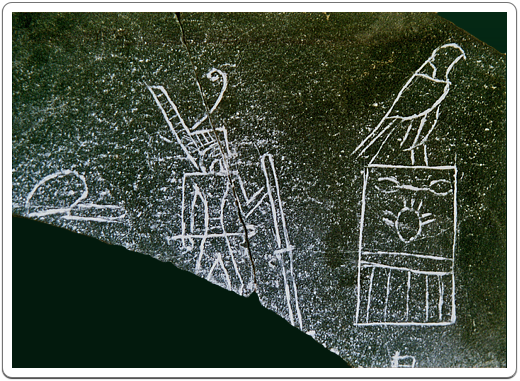Unlike his predecessor, little is known about Horus Anedjib and his reign. It is often assumed that Den was his father, but there are no known sources that confirm this assumption. The name of his mother is not known.
Although it can be assumed that he had one or more wives and fathered one or more children, there are no sources that mention any of those. The hypothesis that his successor, Horus Semerkhet, may have been his son, making Semerkhet’s mother Anedjib’s wife, is merely based on the assumption that the succession to the throne went from father to son.
Only two years of his reign, the penultimate and the last year, have been preserved on Cairo Fragment CF1 of the Annals Stone. Both entries, however, are totally destroyed, save for the Nile height measurement in Anedjib’s last year.
No year labels from his reign have been found or identified as such. This is in sharp contrast with the 26 years that Manetho credits him, and even more with the 74 years he is given in the Turin King-List.
Based on the number of sources, it is assumed that he reigned for 8 to 10 years at most, a short reign that may indicate that he was already of age when he came to power.
Despite this lack of dated sources, Anedjib is fairly well attested in the archaeological record. Objects bearing his name have been found in Abydos and Saqqara and include stone vessels, ivory tags and seal impressions. The seal impressions record the foundation of a new royal fortress named “Horus, golden of body” and a royal residence named “Horus, starry of body”, the latter name a reference to the celestial nature of the falcon-god Horus.

One of several carvings referring to cult statues of Horus Anedjib.
Several cult statues of Anedjib were made, as is shown by a number of carvings of a statue of a man wearing a crown in combination with Anedjib’s name.
Anedjib was buried in a tomb, labeled Tomb X at Umm el-Qa’ab, which he chose to build to the northwest of Merneith’s tomb and the southwest of the subsidiary graves of Djet’s tomb. Whether this choice was the result of practical considerations, or an indication that he wanted to distance himself from his predecessors, is not known. In the latter case, one could hypothesise that Anedjib wanted to confirm a closer relationship to Djet than to Den.